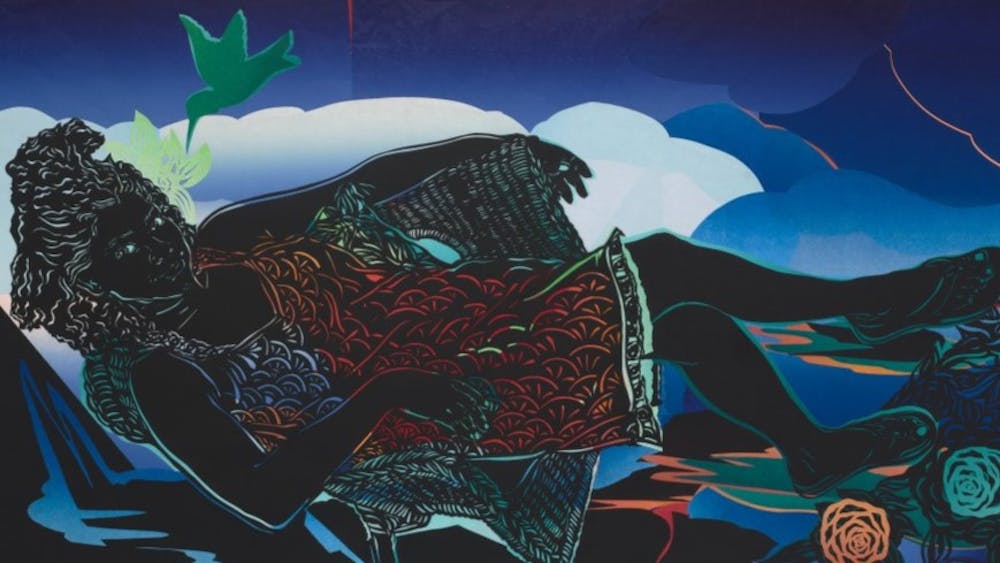What makes an exhibition so immersive that it seamlessly draws viewers into both its external world and inner life? In The Illuminated Body, a new art exhibition by Seattle artist Barbara Earl Thomas at the Arthur Ross Gallery, viewers are invited to explore this very question.
Thomas’s nine large–scale pieces pay tribute to personal friends and influential Black cultural icons, including August Wilson, Seth Parker Woods, and Charles Johnson. With meticulous attention to every portrait—from the nuanced interplay of light and shadow to the vibrant and mysterious elements of her hand–cut paper technique—Thomas captures the luminous moments of individuals lost in creativity, creating a deeply personal and visually arresting experience.
“I wanted to honor that common, everyday existence where we make our mark,” Thomas says. Capturing the brilliance of other artists is a challenging task, a kind of metalanguage. In The Illuminated Body, Thomas takes on this near-impossible feat: encapsulating the radiant light of creative excellence.
The Illuminated Body marks the first time Thomas’s work has been showcased in Philadelphia. A visual storyteller for over 40 years, Thomas weaves together themes from history, literature, folklore, mythology, and the Bible to reflect the social fabric of our times. She hopes the exhibition resonates with Penn students. “My work is pretty grounded, and I think anyone can relate,” Thomas says. “I hope Penn students can take what they learn here and share it with the world.”
Thomas consistently allows light to seem as if it emanates from within the piece itself—a vivid symbol of the creativity and vitality of the real people she represents. What sets this exhibition apart is Thomas’ commitment to portraying creativity in all its forms, whether as quiet imagination, gentle daydreaming, or bold performance. She pays tribute to the history behind each achievement and the personal story of each individual, celebrating their unique contributions.
Through her art, Thomas seeks to present a richer, more diverse portrait of Black life, celebrating the full spectrum of human experience beyond the confines of adversity. In Joyful Noise, Thomas portrays her lifelong friend and cellist Seth Parker Woods. This piece intertwines her personal histories and lineages with her own art and that of painter Jacob Lawrence. The figures at the top are from Lawrence's first panel, which depicts people boarding trains to a new future and is also featured on Parker Woods' album Difficult Grace. Thomas has positioned Parker Woods at the center, capturing the climax of his creative performance, and even replicated a shirt he wears in his show. These elements come together to honor both the past and our present futures.
Rather than identifying as an artist, Thomas sees herself as a maker—a problem–solver who finds elegance in simplicity. She draws inspiration from her parents, who migrated from the South to Seattle, particularly her mother, a talented sewer, embroiderer, and crocheter. Thomas’ work is deeply human and collaborative, actively engaging the people she brings into her studio. In an interview with Art With the Matter, Thomas shared, “My cutters have been between 16 years old and 75. So it’s not about what subject they bring; it’s whether or not they bring a hand, an eye, and an open willingness to just jump in.”
Thomas doesn’t just depict the spark of life; she invites viewers to be immersed in it. She created The Transformation Room, a luminous installation made entirely of intricate paper–cut murals illuminated by light. This space offers viewers a moment of calm and inspiration, drawing them into a world of wonder. The installation evokes a collective sense of awe, with each visitor visually echoing the beauty they encounter upon entering.
This is more than just an exhibition—it's an opportunity to step away from the rush of campus life and experience the quiet, transformative power of art firsthand.

